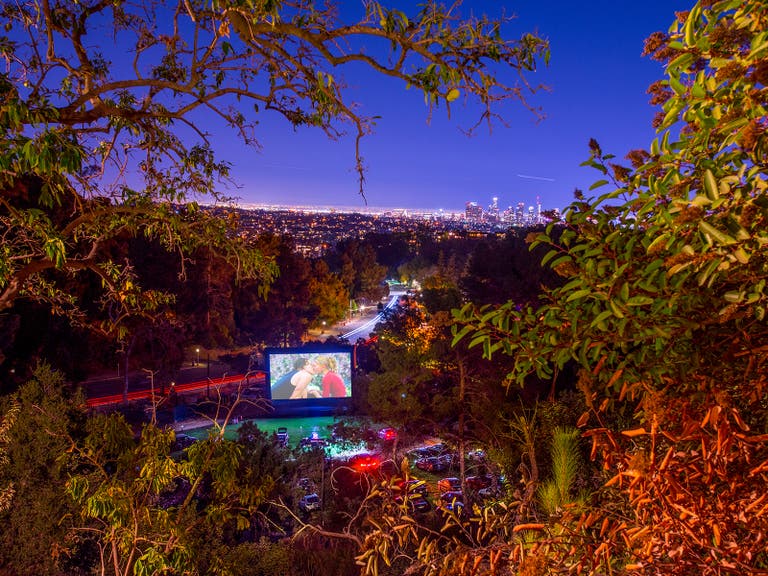Cathedral of Our Lady of the Angels

Sometimes, buildings are more than just functional places where people seek shelter or gather for events. When everything comes together just right, they serve as places of community and worship, sacred spaces where the spiritual journey is brought to life. The Cathedral of Our Lady of the Angels is one of L.A.'s most innovative buildings, able to inspire visitors with its warm, inviting interior, perfect for introspection. Outside, blunt, asymmetrical walls stretch the definition of a cathedral, challenging visitors to rethink their ideas about sacred buildings.
If the beauty of the cathedral compels you to learn more about the art, history and significance of this L.A. landmark, free guided tours are available Monday–Friday at 1 p.m. For groups of 10 or more, call 213.680.5215.
History
L.A.’s newest cathedral, and one of the largest in the world, the Cathedral of Our Lady of the Angels became a necessity in 1996 when the City of Los Angeles condemned St. Vibiana Cathedral, which had served as the seat of the Archdiocese of Los Angeles since 1876. The Northridge earthquake in 1994 had compromised the structural integrity of St. Vibiana, and the need for a new cathedral became a top priority for civic and church leaders.
The Cathedral Advisory Board considered several locations for the new cathedral, finally settling on the 5.6-acre site on Bunker Hill near the Hollywood Freeway. After Pritzker Prize-winning architect José Rafael Moneo was selected to design the new building, he began working closely with Cardinal Roger Mahoney to create a structure that would echo centuries of church design yet resonate in a contemporary context. As Moneo put it, the building should be “one of those examples where 20th-century architecture touched the sense of the sacred.”
On Sept. 21, 1997, the Archdiocese held the official ground-blessing ceremony for the new cathedral, and construction began shortly afterward. More than 2,000 people contributed to the construction process, taking five years to bring the building from the design stage to completion. The formal dedication ceremony was held on Sept. 2, 2002, unveiling a building that is almost entirely devoid of right angles with flat, fortress-like outer walls made from architectural concrete poured into forms. In an attempt to safeguard against the previous cathedral’s fate, Moneo’s masterpiece was built on 198 rubber pads, allowing it to float and move laterally in the event of seismic activity.
Architectural Details
At 65,000 square feet, 11 stories and 151 million pounds, the Cathedral of Our Lady of the Angels is a massive structure built to last 500 years.
Inside the cathedral, natural light floods the main interior space through slanted shafts in the walls as well as through the cross “lantern” at the front of the building. Rather than the standard stained glass windows, Moneo employed glass-sheltered alabaster mosaics to flood the nave with opaque light in subtle earth tones. In fact, the building features one of the largest single uses of alabaster windows in the world, measuring more than 30,000 square feet.
Nine steel trusses and four main walls support the vast ceiling, eliminating the need for interior pillars and providing clean sightlines for the entire congregation. The floor was laid out in more than 60,000 small paving stones of Spanish Jana limestone.
In a break with tradition, the main entrance to the cathedral is located at the front of the building, guiding visitors through a long ambulatory encircling the interior nave. Such a configuration invites visitors to reflect on their spiritual journey as they’re drawn toward the center of the cathedral.
The Artwork
At the main entrance, sculptor Robert Graham’s eight-foot statue of Our Lady of the Angels and his 25-ton bronze doors welcome visitors as they cross the threshold and enter the sacred space of the cathedral. The doors feature an elaborate structure of pre-Christian symbols from around the globe. It also features 15 manifestations of the Virgin, some European in origin and others recognizable to the indigenous cultures of the New World.
Inside the cathedral, a series of 25 tapestries adorn the south and north walls of the nave, depicting 135 holy men, women and children — some saints and church leaders, others anonymous holy people. The Communion of Saints, as the cycle is known, is one of the largest tapestry collections hanging in a Catholic church in the United States. It’s the work of noted California artist John Nava, who employed stone textures and subtle earth tones in the tapestries, calling to mind Italian frescoes of antiquity.
Other artistic flourishes include the Altar of Angels, constructed from a six-ton slab of Turkish Rosso Laguna marble, the bishop’s cathedra (Latin for “chair”), built with wood from every continent except Antarctica and constructed using Old World joinery techniques, 12 bronze dedication candleholders featuring angels with outstretched wings, and the dark bronze crucifixion sculpture by Simon Toparovsky.
555 W. Temple St., Downtown Los Angeles, 90012
213.680.5200

